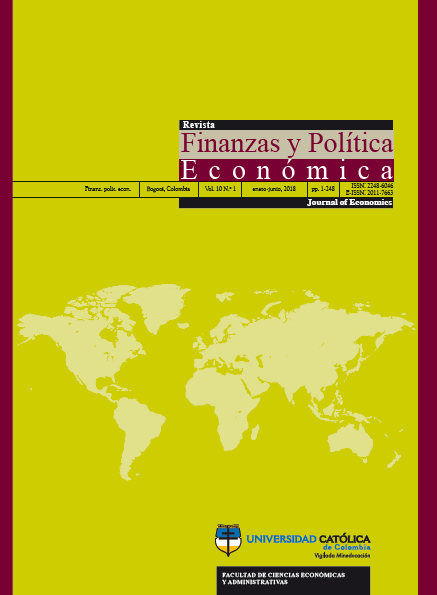Esta revista está autorizada por una licencia de atribución Creative Commons (CC BY-NC-SA 4.0) Attribution-Non Commercial 4.0 International. Para las licencias CC, el principio es el de la libertad creativa. Este sistema complementa el derecho de autor sin oponerse a este, conscientes de su importancia en nuestra cultura. El contenido de los artículos es responsabilidad de cada autor y no compromete, de ninguna manera, a la revista o a la institución. Se permite la divulgación y reproducción de títulos, resúmenes y contenido total, con fines académicos, científicos, culturales, siempre y cuando, se cite la respectiva fuente. Esta obra no puede ser utilizada con fines comerciales.
La revista no cobra a los autores por la presentación o la publicación de sus artículos
Resumen
Este artículo busca determinar si la estrategia de inflación objetivo modificó la estructura económica de Colombia, al provocar un cambio estructural. Para ello, se empleó un modelo de vectores autorregresivos y posteriormente dos pruebas de cambio estructural: la prueba de Chow y la prueba de máxima verosimilitud. Se estimó un modelo VAR de cuatro variables que tienen una periodicidad mensual y cubren el periodo 1995M04 hasta 2015M05. Los resultados de la regresión permiten concluir que la adopción de la estrategia de inflación objetivo sí representó un cambio estructural para la economía colombiana y ayudó a mantener baja y estable la inflación.
Palabras clave

Citas
Agénor, P-R. y Montiel, P (1999). Development macroeconomics. Nueva Jersey: Princeton University Press.
Allsopp, C. y Vines, D. (2000). The assessment: macroeconomic policy. Oxford Review of Economic Policy, 16(4), 1-32.
Angeriz, A. y Arestis, IP (2009). Objetivo de inflación: evaluación de la evidencia. Investigación Económica, 68, 21-46.
Bai, J. y Perron, P (2003). Computation and analysis of multiple structural change models. Journal of Applied Econometrics, 18, 1-22
Ball, L. (1999). Policy rules for open economies En J. Taylor (Ed), Monetary policy rules. Chicago: University of Chicago Press.
Ball, L. y Sheridan, N. (2005). Does inflation targeting matter? Chicago: Universidad de Chicago.
Barro, R. J. y Gordon, D. B. (1983). Rules, discretion and reputation in a model of monetary policy. Journal of Monetary Economics, 12(1), 101-121.
Bernanke, B. S., Laubach, T, Mishkin, F. S. y Posen, A. S. (2001). Inflation targeting: Lessons from the international experience. Nueva Jersey: Princeton University Press.
Candelon, B. y Lütkepohl, H. (2001). On the reliability of Chow-type tests for parameter constancy in multivariate dynamic models. Economics Letters, 73, 155-160.
Clavijo, S., Vera, A. y Vera, N. (2015). Política monetaria: reglas y discreción. Panorama Económico, 23, 31-38.
Cukierman, A. (2002). Are contemporary central banks transparent about economic models and objectives and what difference does it make? Recuperado de https://files.stlouisfed.org/files/htdocs/publications/review/02/07/15-36Cukierman.pdf
García, C. (2000). Chilean stabilization policy during the 1990. Los Angeles: Universidad de California.
Giraldo, A., Misas, M. y Villa, E. (2012). Reconstructing Colombia's Recent History of Monetary Policy from 1990 to 2010. Ensayos sobre Política Económica, 30(67).
Gómez, J. (2006). La política monetaria en Colombia. Bogotá: Banco de la República.
Goodfriend, M. y King, R. (1997). The new neoclassical synthesis and the role of monetary policy. NBER Macroeconomics Annual, 12, 231-296.
Hamann, F., Hofstetter, M. y Urrutia, M. (2014). Inflation targeting in Colombia, 2002-12, Recuperado de https://www.questia.com/library/journal/1P3-3461526991/inflation-targeting-in-colombia-2002-12
Honda, Y. (2000). Some tests on the effects of inflation targeting in New Zealand, Canada, and the UK. Economics Letters, 66, 1-6.
Huh, C. (1996). Some evidence on the efficacy of the UK inflation targeting regime: An out-of-sample forecast approach. International Discussion Papers, 565.
Inclán, C. y Tiao, G. C. (1994). Use of cumulative sums of squares for retrospective detection of changes of variance. Journal of the American Statistical Association, 89(427), 913-923.
Jordà, O. (2005). Estimation and inference of impulse responses by local projections. American Economic Review, 95(1), 161-182.
Jordà, O. (2009). Simultaneous confidence regions for impulse responses. Review of Economics and Statistics, 91(3), 629-647.
Kamal, M. (2010). Inflation targeting in Brazil, Chile and South Africa: An empirical investigation of their monetary policy framework. Recuperado de https://deepblue.lib.umich.edu/bitstream/handle/2027.42/133018/wp1004.pdf?sequence=1
Kamil, H., Pulido, J. y Torres, J. (2010). El "IMACO": un índice mensual líder de la actividad económica en Colombia, Borradores de Economía, 609.
Kuttner, K. N. y Posen, A. S. (1999). Does talk matter after all? Inflation targeting and central banking behavior. Recuperado de https://econpapers.repec.org/paper/iiewpaper/wp99-10.htm
Kydland, F. E. y Prescott, E. C. (1977). Rules rather than discretion: The inconsistency of optimal plans. Journal of Political Economy, 85(3), 473-492.
Lane, T y Van Den Heuvel, S. (1998). The United Kingdom's experience with inflation targeting (Working Paper 98/87). Washington: Fondo Monetario Internacional.
Londoño. A., Tamayo, J. y Velasquez, C. (2012). Dinámica de la política monetaria e inflación objetivo en Colombia: una aproximación FAVAR. Ensayos sobre Política Económica, 30(68), 15-71.
Masson, P, Savastano, M. y Sharma, S. (1997). The scope for inflation targeting in developing countries (Working paper 97/130). Washington: Fondo Monetario Internacional.
McCallum, B. T (1984). Credibility and monetary policy price stability and public policy. Recuperado de https://www.kansascityfed.org/publicat/sympos/1984/S84mccal.PDF
Mishkin, F. y Posen, A. S. (1997). Inflation Targeting: lessons from four countries (NBER Working Paper 6126). Recuperado de https://econpapers.repec.org/paper/nbrnberwo/6126.htm
Perron, P (1989). The great crash, the oil price shock, and the unit root hypothesis. Econometrica, 57(6), 1361-1401.
Perrotini, I. (2014). Precios de activos y política monetaria en la nueva síntesis neoclásica. Revista Mexicana de Economía y Finanzas, 9(1), 89-102.
Rodríguez, H. (2011). Estudio del fenómeno de inflación importada vía precios del petróleo y su aplicación al caso colombiano mediante el uso de modelos VAR para el periodo 2000-2009. Estudios Gerenciales, 27(121), 79-97.
Romer, D. (2000). Keynesian macroeconomics without the LM curve. Journal of Economic Perspectives, 14(2), 149-69.
Svensson, L. E. (2000). Open-economy inflation targeting. Journal of International Economics, 50(1), 155-183.
Taylor, J.B. (1993). Discretion versus policy rules in practice. Carnegie-Rochester Conference Series on Public Policy, 39, 195-214.
Taylor, J.B. (2000a). Teaching modern macroeconomics at the principles level. American Economic Review, 90(2), 90-94.
Taylor, J, B., (2000b). Low inflation, pass-through, and the pricing power of firms. European Economic Review, 44, 1389-408.
Urrutia, M. (2006). Cambio en los instrumentos de política monetaria. Coyuntura Económica, 35 (2), 93-100.





























